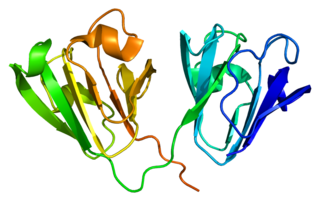
Gamma-crystallin D is a protein that in humans is encoded by the CRYGD gene.

Laminin subunit alpha-2 is a protein that in humans is encoded by the LAMA2 gene.

Lens fiber major intrinsic protein also known as aquaporin-0 is a protein that in humans is encoded by the MIP gene.

Beta-crystallin B2 is a protein that in humans is encoded by the CRYBB2 gene.

Crystallin, gamma C, also known as CRYGC, is a protein which in humans is encoded by the CRYGC gene.

Gap junction alpha-3 protein is a protein that in humans is encoded by the GJA3 gene.

Translation initiation factor eIF-2B subunit gamma is a protein that in humans is encoded by the EIF2B3 gene.

Beta-crystallin B1 is a protein that in humans is encoded by the CRYBB1 gene. Variants in CRYBB1 are associated with autosomal dominant congenital cataract.

Beta-crystallin A3 is a protein that in humans is encoded by the CRYBA1 gene.

Gamma-crystallin S is a protein that in humans is encoded by the CRYGS gene.

Gap junction alpha-8 protein is a protein that in humans is encoded by the GJA8 gene. It is also known as connexin 50.

Heat shock factor protein 4 is a protein that in humans is encoded by the HSF4 gene.

Beta-crystallin A4 is a protein that in humans is encoded by the CRYBA4 gene.

Protein O-mannosyl-transferase 2 is an enzyme that in humans is encoded by the POMT2 gene.

Beta-crystallin B3 is a protein that in humans is encoded by the CRYBB3 gene.

Gamma-crystallin A is a protein that in humans is encoded by the CRYGA gene.

Mu-crystallin homolog also known as NADP-regulated thyroid-hormone-binding protein (THBP) is a protein that in humans is encoded by the CRYM gene. Multiple alternatively spliced transcript variants have been found for this gene.

Lens fiber membrane intrinsic protein is a protein that in humans is encoded by the LIM2 gene.

Alpha-crystallin A chain is a protein that in humans is encoded by the CRYAA gene.

Coiled-coil and C2 domain-containing protein 2A that in humans is encoded by the CC2D2A gene.






















